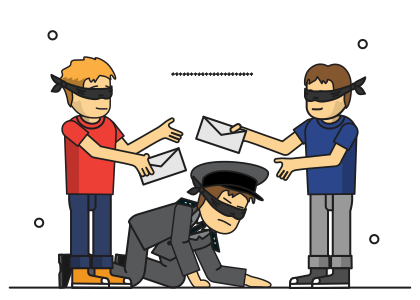Bitmessage is a free messenger with an open source code, reliable tool for anonymous and secure communications online.
Myth
Any address message must have the addressee and the sender.Fact
Bitmessage allows to send messages without recipient and sender. At the same time, it will be read only by recipient whom you send it to.Why Bitmessage
Architecture Bitmessage is arranged in a following way: a message is sent absolutely to ALL network computers, but it can be decrypted only by addressee whom it is intended to. It makes absolutely impossible to control user correspondence due to the lack of information about the recipient (and the sender).
Remember the story of Caesar's cipher when he sent to his generals encrypted messages. Although barbarians could not read the encrypted text, they could track down with whom correspondence was going on, and could intercept the message to the addressee. And imagine a situation where a single message Caesar sends right away to all his generals and even barbarians, everyone gets this encrypted message, but it can be read only by an owner of secret cipher. In this the case, the addressee of correspondence is unknown and cannot be identified, since how can you find out who has this secret?
Bitmessage uses encryption open key, that is why even the sender cannot decipher the sent message, it can be done only by the addressee. Encrypted messages are stored on the network for four days (by default settings).
Bitmessage is the only anonymous messenger. I don’t know any other anonymous messengers. Many people think that XMPP/Jabber are anonymous, however, they are not. XMPP/Jabber are not anonymous, since there is an addressee, they have an IP address, which is stored in the server logs, there are data when the sender on a network, where they got the message from, one can guess how long the correspondence was conducted. Bitmessage has no addressee, no server, no logs.
Installing Bitmessage
The program can be downloaded on the official website.
When being installed, the program will ask if you do not want to specify some special connection settings, you do not need it, so select Connect now. In macOS you would need to enter the System Settings ...> Security and there you can confirm the launch of the program from the uninstalled manufacturer.
Then allow the program network connection.
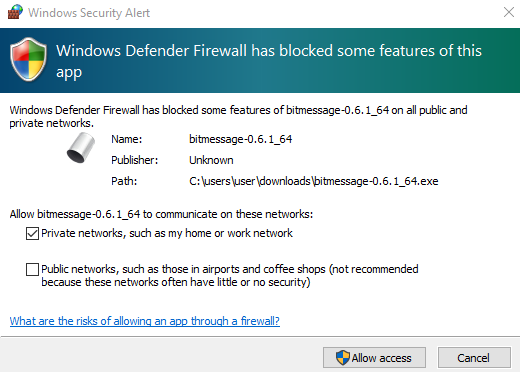
The program is ready to work.
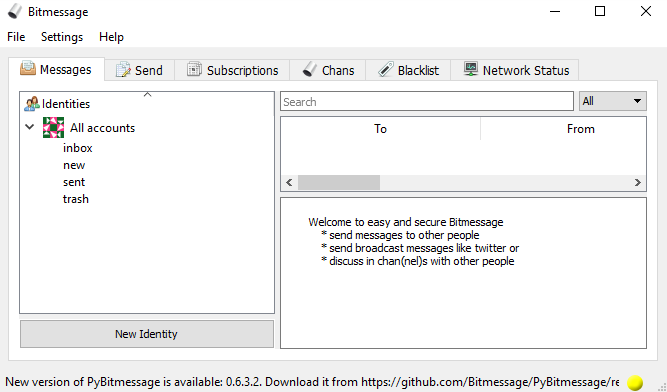
It is a little harder to install the program for the users of operating systems based on Linux. Run command line.
First set up Python using commands:
sudo apt-get install python openssl git python-qt4
We carry out cloning Bitmessage of repository on GitHub with the commands:
git clone https://github.com/Bitmessage/PyBitmessage $ HOME / PyBitmessage
Run Bitmessage with commands:
~ / PyBitmessage / src / bitmessagemain.py
Creating a Bitmessage account
Your account has already been created. Similar to using Bitcoin wallets, when you run Bitmessage, it will automatically check the system folder for the keyfiles required for decrypting the incoming messages. If it fails to identify any keyfiles, it creates a new one.
The file is named keys.dat, and it can be found in the system folder titled PyBitmessage,while the folder itself, if you are using Windows, can be found in user’s personal documents (that can be easily located by the file’s name keys.dat).
Just like the wallet.dat file in Bitcoin, the keys.dat file should to be stored reliably and cannot be lost, otherwise you will lose all your credentials records and correspondence.
In the case of macOS in Finder enter the command cmd + shift + G and in the opened window enter / Users / (name of your user) / Library / Application Support / PyBitmessage /.
You will see the folder with keys.
Keys.dat is better to be kept in a safe place at the same time. When moving to a new device you need to transmit keys.dat as well.

Create Bitmessage Address
Address has to be generated with the help of the address generator. To do this, select Create new address in the program.
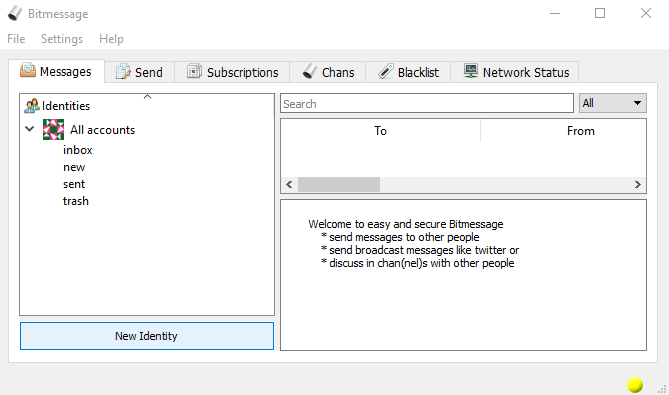
You will see the address generation menu.
Developers of the program offer two ways of generation but to create anonymous protected address, select "Use a random number generator." In this case your access key will become keys.dat.
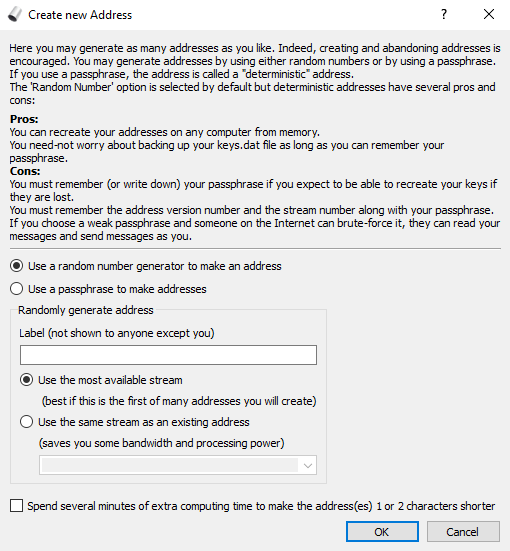
On completion you will see your address in the tab Messages. Click on the address with right button mouse to copy it. This address is the public key that will be used to encrypt messages for you.
As you probably know, in the asymmetric encryption there is public and private keys. Public key can encrypt message, which then can be deciphered only with private key. Even if one has public key that encrypted the message, they can’t decrypt it with the one. The address, like the account number, is the public key, keys.dat is private.
Sending messages in Bitmessage
Let's practice sending messages and first send an email to yourself. Create some addresses, select one of created addresses as a recipient, and then copy it to the clipboard.
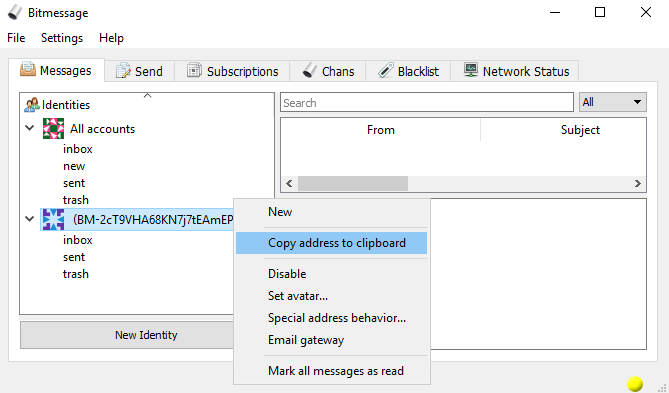
Then go to the Send tab, fill in the required fields, select any other address created as the sender and send the message.
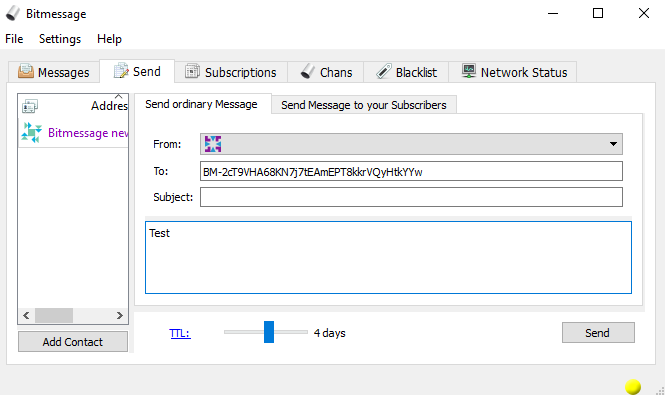
Since we sent message to ourselves, then in the tab Inbox should appear the received message.
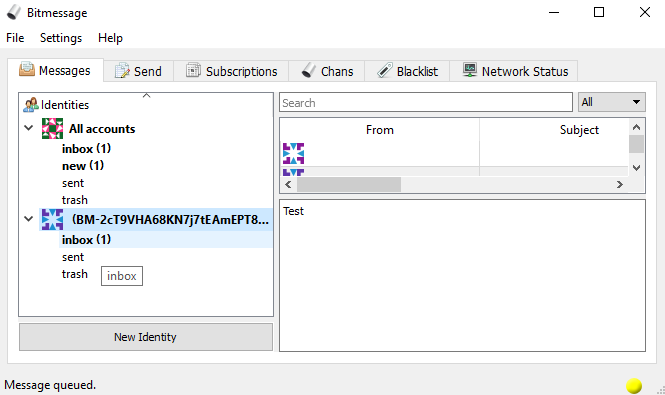
The received messages should be deleted after reading.
Tip
After reading remove the received letters and messages. Let it become your habit.If you want to get messages from other users of Bitmessage, just pass them one of addresses. For example, my address is BM-2cTC98PvJKxiru3yL1xD3dppRZcVzgEias.
Deleting Bitmessage keys and logs
You may need to instantly destruct your saved correspondence and Bitmessage decryption keys. You can do it manually by opening the system folder PyBitmessage (we’ve mentioned where it is located in the above section of the article) and deleting all the files from it.

It is especially important to delete keys.dat and messages.dat. Deletion of keys.dat file will disable decryption of emails sent to your addresses. If it is important for you not to lose this opportunity, backup of keys.dat is recommended to be kept in a safe place. Removing messages.dat will result in loss of received and sent messages.
One can make this automatically by adding specified files to the kill list in Panic Button. Panic Button is a program for emergency destruction data, it removes confidential information such as browser history, saved passwords, history of open pictures and documents. Panic Button can be run manually or in logical mode bombs upon getting unauthorized access to the computer.
Panic Button is able to delete files selected by user reliably. In the list files you need to delete you need to specify keys.dat, messages.dat and knownodes.dat. By the way, Panic Button also will remove the information about launching Bitmessage.
